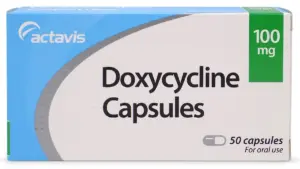Before diving into aluminum chloride, it’s important to understand what antiperspirants are and how they differ from deodorants.
Antiperspirants are products designed to reduce sweating. They work by temporarily blocking the sweat glands, which reduces the amount of sweat reaching the skin’s surface. This helps keep you dry and reduces the moisture that can lead to body odor.
Antiperspirants primarily function through aluminum-based compounds that create a physical barrier over sweat glands. This barrier minimizes the amount of sweat that can pass through to the skin, effectively reducing wetness. The temporary nature of this blockage means that regular application is necessary for continued effectiveness.
While both antiperspirants and deodorants aim to address body odor, their methods differ significantly. Deodorants solely target the bacteria responsible for odor, without affecting perspiration levels. Understanding this distinction is crucial for selecting the right product based on personal needs.
Despite its sometimes inconvenient nature, sweating is essential for regulating body temperature and eliminating toxins. By understanding the body’s natural processes, individuals can make more informed choices about how they manage perspiration.
The active ingredients in antiperspirants are typically aluminum-based compounds, such as aluminum chloride, aluminum chlorohydrate, and aluminum zirconium. These compounds are responsible for blocking sweat production.
Aluminum chloride is a highly effective compound known for its ability to reduce excessive sweating, making it a staple in prescription-strength antiperspirants. Its efficacy comes from its ability to form a plug within sweat glands, reducing the flow of sweat to the skin’s surface.
Aluminum chlorohydrate is a gentler alternative to aluminum chloride, often found in over-the-counter products. While it is less potent, it is suitable for individuals with moderate sweating, providing a balance between effectiveness and skin sensitivity.
This compound combines aluminum with zirconium to enhance the antiperspirant’s efficacy and minimize skin irritation. It is commonly used in roll-on and stick formulations, offering a compromise between strength and comfort.
Aluminum chloride is one of the most effective compounds used in antiperspirants. Its role is crucial in managing sweat production, but how exactly does it work?
When applied to the skin, aluminum chloride interacts with the sweat glands. It forms a temporary plug within the sweat duct, preventing sweat from reaching the skin’s surface. This plug is formed by the reaction of aluminum ions with electrolytes in sweat, leading to the formation of a gel-like substance.
The interaction between aluminum chloride and sweat glands is a highly specialized chemical process. Aluminum ions react with the electrolytes present in sweat, creating a gel-like plug that effectively blocks the sweat duct. This mechanism not only reduces sweat but also limits the moisture that contributes to bacterial growth and odor.
The plug formed by aluminum chloride is not permanent; it is naturally expelled as part of the skin’s normal shedding process. This means that regular application is necessary to maintain its effectiveness, aligning with the body’s natural cycles of skin renewal.
The effectiveness of aluminum chloride can vary among individuals, influenced by factors such as skin type, sweat levels, and application method. Understanding these variables can help users optimize their use of antiperspirants for maximum benefit.
Aluminum chloride is particularly effective for those with excessive sweating, a condition known as hyperhidrosis. It is commonly found in prescription-strength antiperspirants due to its high efficacy.
For individuals with hyperhidrosis, the high potency of aluminum chloride offers a powerful tool for managing excessive sweating. Its ability to significantly reduce perspiration levels helps improve the quality of life for those affected by this condition.
Prescription-strength antiperspirants containing aluminum chloride provide a targeted solution for severe cases of sweating. These formulations are carefully balanced to maximize efficacy while minimizing potential irritation.
While effective, long-term use of aluminum chloride-based products should be monitored to ensure continued skin health. Users are encouraged to follow recommended guidelines and consult healthcare professionals if concerns arise.
While aluminum chloride is effective, it has sparked concerns regarding its safety and potential health risks.
The U.S. Food and Drug Administration (FDA) classifies aluminum chloride as safe for use in over-the-counter antiperspirants. However, concerns have arisen about its potential link to health issues.
The FDA has established guidelines to ensure the safe use of aluminum chloride in consumer products. These regulations are based on extensive research and are designed to protect users from potential adverse effects, providing a framework for safe usage.
Scientific research continues to explore the long-term effects of aluminum chloride exposure. Ongoing studies aim to clarify any potential links to health issues, ensuring that consumers have access to the most up-to-date information.
Educating consumers about the safety and proper use of aluminum chloride is essential for informed decision-making. Clear labeling and accessible information empower individuals to choose products that align with their health priorities.
- Breast Cancer: Some studies have suggested a possible link between aluminum compounds and breast cancer. However, current research does not provide conclusive evidence that aluminum chloride in antiperspirants increases cancer risk.
The potential link between aluminum compounds and breast cancer remains a topic of debate within the scientific community. While some studies suggest a correlation, others refute these findings, highlighting the complexity of cancer research and the need for further investigation.
Evaluating the body of scientific evidence is crucial for understanding the true risk associated with aluminum chloride. Comprehensive reviews of existing studies help distinguish between correlation and causation, providing clarity for consumers.
Individuals are encouraged to assess their personal risk factors and consult healthcare professionals when making decisions about antiperspirant use. Personalized guidance ensures that choices are tailored to individual health needs and concerns.
- Kidney Health: There have been concerns about aluminum accumulation in the body, particularly for individuals with compromised kidney function. It’s advised that people with kidney issues consult a doctor before using aluminum-based antiperspirants.
Concerns about aluminum accumulation in the body center around its potential impact on kidney function. Research is ongoing to determine the extent to which aluminum chloride contributes to systemic exposure and its implications for individuals with renal impairments.
For those with existing kidney conditions, consulting a healthcare provider before using aluminum-based antiperspirants is recommended. Medical professionals can provide personalized advice based on an individual’s health status and needs.
Regular monitoring of kidney health and proactive risk management strategies can help mitigate potential concerns associated with aluminum exposure. Staying informed about new research developments is key to making safe choices.
- Skin Irritation: Aluminum chloride can cause skin irritation, especially if applied to broken or freshly shaved skin. Users are advised to follow product instructions to minimize irritation.
Skin sensitivity varies among individuals, with some more prone to irritation from aluminum chloride. Identifying personal triggers and adopting appropriate application techniques can help minimize adverse reactions.
To reduce the risk of irritation, users should follow best practices when applying antiperspirants. This includes applying to clean, dry skin, avoiding freshly shaved areas, and allowing the product to dry completely before dressing.
For those with sensitive skin, exploring alternative antiperspirant formulations or natural options may provide relief. Consulting dermatologists can offer additional insights into managing skin reactions effectively.
For those concerned about aluminum chloride in antiperspirants, there are natural alternatives available.
Natural antiperspirants typically use ingredients like baking soda, cornstarch, and essential oils to absorb moisture and neutralize odor. These products do not block sweat glands but instead focus on reducing odor-causing bacteria and absorbing sweat.
Natural antiperspirants rely on a combination of natural ingredients to achieve their effects. Baking soda neutralizes odors, while cornstarch absorbs moisture. Essential oils add fragrance and antibacterial properties, offering a holistic approach to sweat management.
The growing demand for natural personal care products reflects a broader trend toward health-conscious consumerism. Natural antiperspirants appeal to those seeking to reduce their chemical exposure while maintaining effectiveness.
Users of natural antiperspirants should be aware of their different application methods and effectiveness levels. These products may require more frequent application and adjustments to achieve desired results.
- Pros: Natural antiperspirants are free from synthetic chemicals and aluminum compounds, making them a good choice for those with sensitive skin or those seeking a more natural lifestyle.
Natural antiperspirants offer a gentler alternative for individuals with sensitive skin, reducing the risk of irritation and allergic reactions. Their mild formulations cater to those who prioritize skin health and comfort.
For consumers committed to natural lifestyles, these products align with personal values and environmental considerations. Their minimal environmental impact and use of sustainable ingredients resonate with eco-conscious individuals.
Natural antiperspirants often feature unique, plant-based fragrances that differentiate them from traditional products. This variety allows users to personalize their scent preferences while adhering to natural principles.
- Cons: They may not be as effective in controlling sweat as aluminum-based antiperspirants, particularly for those with hyperhidrosis.
While natural antiperspirants excel in odor management, they may fall short in controlling excessive sweating. Individuals with hyperhidrosis may find these products less effective, necessitating a balance between natural preferences and sweat control needs.
The effectiveness of natural antiperspirants can vary based on factors such as body chemistry and activity level. Users are encouraged to experiment with different formulations to identify the best fit for their unique requirements.
Due to their milder nature, natural antiperspirants may require more frequent reapplication compared to their aluminum-based counterparts. Users should plan accordingly to maintain desired levels of freshness and dryness.
Aluminum chloride plays a significant role in the effectiveness of antiperspirants, offering a solution for those looking to reduce sweat and stay dry. While concerns about its safety exist, current research supports its use as safe for most individuals. As with any product, it’s important to consider personal health needs and preferences. For those seeking alternatives, natural antiperspirants provide a viable option, though they may offer different levels of effectiveness.
Understanding the ingredients in your personal care products empowers you to make informed decisions that align with your health and lifestyle preferences. Whether you choose a traditional antiperspirant or a natural alternative, the key is finding what works best for you.
The choice between aluminum-based and natural antiperspirants involves weighing efficacy against safety and personal values. By staying informed and considering individual needs, consumers can achieve a balance that aligns with their priorities.
Personal preferences play a crucial role in selecting antiperspirants. Factors such as scent, texture, and application method contribute to the overall experience, underscoring the importance of trial and experimentation.
Advancements in antiperspirant technology continue to emerge, offering new solutions and formulations. Staying updated on these developments provides opportunities to explore innovative options that meet evolving consumer demands.



